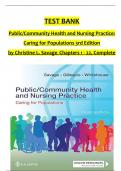Examen
TEST BANK For Public / Community Health and Nursing Practice: Caring for Populations, 3rd Edition, Christine L. Savage, Verified Chapters 1 - 22, Complete Newest Version
- Cours
- Établissement
- Book
TEST BANK For Public / Community Health and Nursing Practice: Caring for Populations, 3rd Edition, Christine L. Savage, Verified Chapters 1 - 22, Complete Newest Version TEST BANK For Public / Community Health and Nursing Practice: Caring for Populations, 3rd Edition, Christine L. Savage, Verified ...
[Montrer plus]



